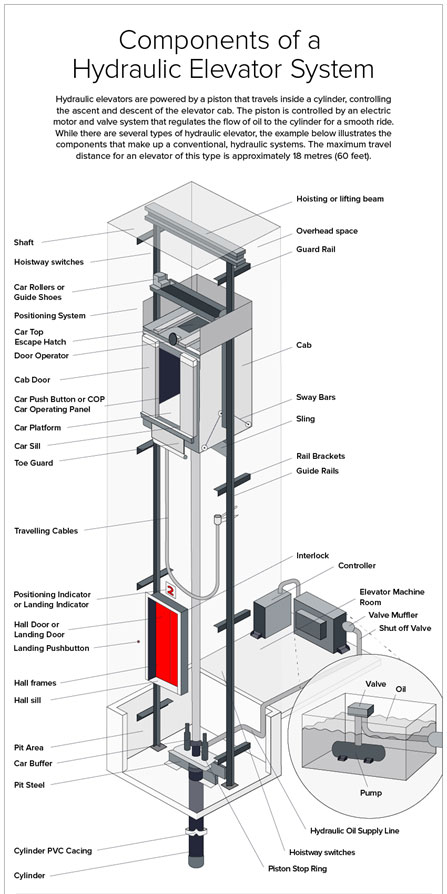
This is the main part of Elevator which is designed for enclosed transport of passengers & goods
it is used to support the car (passing over the drive sheave to the counterweight) & pull the car. Usually number of lays depends on load & speed.
A traction machine is used on all traction elevator equipment types. A standard traction machine consists of a motor, drive sheave, brake and machine bed plate. The traction machine motor turns the drive sheave shaft to turn the drive sheave. As the sheave turns the hoist ropes pass over the drive sheave and pull the car through the hoistway.
An Elevator controller is a system to control the elevators, either manual or automatic.
The controller usually tune down the voltage between 12V to 24V to the controlling system, only the motor needs 3-phase power supply. The low voltage power supply is for the controlling component and the fixtures to control the elevator
Everything that works under electricity must have a motor attached for the functioning & driven by VVVF drives.
In practice, elevators work in a slightly different way from simple hoists. The elevator car is balanced by a heavy counterweight that weighs roughly the same amount as the car when it's loaded 40%-50% (in other words, the weight of the car itself plus 40–50 percent of the total weight it can carry). When the elevator goes up, the counterweight goes down—and vice-versa, which helps us in four ways:
The space enclosed by fireproof walls and elevator doors for the travel of one or more elevators, dumbwaiters or material lifts. It includes the pit and terminates at the underside of the overhead machinery space floor or grating, or at the underside of the roof where the hoistway does not penetrate the roof.
Steel T-shaped or formed sections with guiding surfaces installed vertically in a hoistway to guide and direct the course of travel of an elevator car and elevator counterweights.
The buffer is an apparatus located at the bottom of elevator designed to protect people. Buffers can stop a descending car by accumulating or dissipating the kinetic energy of the car.
Most elevators have an entirely separate speed-regulating system called a governor, which is a flywheel with mechanical arms built inside it. Normally the arms are held inside the flywheel by springs, but if the lift moves too fast, they fly outward, pushing a lever mechanism that trips one or more braking systems. First, they might cut power to the lift motor. If that fails and the lift continues to accelerate, the arms will fly out even further and trip a second mechanism, applying the brakes. Some governors are entirely mechanical; others are electromagnetic; still others use a mixture of mechanical and electronic components.
Everyone who's ever travelled in an elevator has had the same thought: what if the cable holding this thing suddenly snaps? Rest assured, there's nothing to worry about. If the cable snaps, a variety of safety systems prevent an elevator car from crashing to the floor.
Each car ran between two vertical guide rails with sturdy metal teeth embedded all the way up them. At the top of each car, there was a spring-loaded mechanism with hooks attached. If the cable broke, the hooks sprung outward and jammed into the metal teeth in the guide rails, locking the car safely in position.
As normal doors, elevator doors are also meant for entry and exit. Elevator door is of two types: Manual doors and Automatic doors.

EROS ELEVATORS, the pioneer of the Indian Elevator Industry was established in 1947, head quartered in Mumbai and with branches in Pune, Bangalore, Ahmedabad, Surat, Rajkot, Nashik, Vapi, Daman & Hyderabad.
9:30 am to 6:00 pm